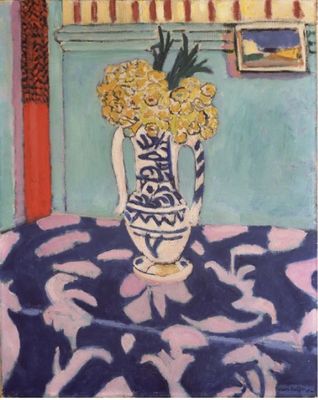
Architecture
Arts
Antiques
Design
Gifts
Home Decor
Interior Design
Green
Food&Wine
Rooms
Textile
Travel

PERIOD: Art Nouveau
Les coucous, tapis bleu et rose signé et daté 'Henri-Matisse 1911-' (en bas à droite) huile sur toile 81 x 65.5 cm. (31 7/8 x 25¾ in.) Peint en 1911 Madame Wanda de Guébriant a confirmé l'authenticité de cette oeuvre. Born in a textile region, surrounded from birth by weavers' and designers' workshops, Matisse collected fabrics from his earliest beginnings as a poor art student, scouring Parisian junk-stalls for scraps of threadbare tapestry, to the last years of his life when his studio became a treasure-house stocked with screens and hangings, curtains, coverlets, costumes, Arab embroideries, oriental carpets and African raffia mats. His collection was strictly practical. He called it his "working library"1, and packed samples from it to take with him when he travelled. Textiles fired Matisse's imagination, and never more so than in the decade leading up to World War I when for the first time he constructed his canvases directly from pure colour. He said that the medium itself - "fresco, gouache, watercolour, coloured stuff" - was not important2. What mattered was the texture of the colour, and the emotion it discharged. Les coucous, tapis bleu et rose, painted in the spring of 1911, belongs to a long experimental sequence based in these years on flowers or fruit and textiles. This particular sub-series was inspired by the Nature morte au géranium of 1910 (fig. 1), a canvas which aroused such passionate enthusiasm in Wassily Kandinsky that he persuaded the Russian collector, Sergei Shchukin, to commission two more still-lifes of the same size on the same theme that winter3. What impressed Kandinsky, Shchukin and the painting's owner, Baron Tschudi, the director of Germany's imperial museums, was the boldness of Matisse's colour, and the unequivocal modernity of his abstract construction. He built his picture round a length of printed cotton known as the toile de Jouy, a favourite and much-painted textile, what Matisse called 'a key volume from my painter's library'4. In Nature morte au géranium the toile de Jouy plunges diagonally across the canvas with the momentum of a waterfall or whirlwind, sweeping the real flower-heads into the careering rhythms of its floral print, assimilating the painted bowl or cushion at the centre of the composition, simultaneously aerating and flattening out the entire picture plane while absorbing the white walls of Matisse's studio within its own chromatic scheme of turquoise, blue and pink. Les Coucous, based on another key volume from Matisse's textile library, is by comparison a model of lucidity and balance. It was painted exactly a year later, at the same time as the great Atelier rose (fig. 2), another cool, light-filled, linear canvas whose overall design centres on the "coloured stuffs" laid out across it like a palette: pale ochre rug, turquoise fabric screen with pink flower blobs, and at the centre what seems to be the same fabric that occupies the lower part of Les Coucous. This was a blue-and-white, hand-woven, woollen rug with a pattern of foliage, flowers, pomegranates and little animals, motifs that would change shape and colour on Matisse's canvases, shifting to pink or creamy yellow and back again to white. He said that the carpet had caught his eye in an antique shop in Madrid on a trip to Spain in the winter of 1910. "It's not in a very good state, but I'll be able to work a lot with it, I think," he told his wife5. He paid a revelatory visit to the Alhambra Palace in Granada before painting his new textile for the first time, combining it with a patterned sofa, a batch of Spanish shawls and the pot of geraniums specially purchased to fulfill Shchukin's order for a pair of still lifes6 (fig. 3): Canvases which transpose the standard still-life components of flowers, fruit and fabric into a riotous oriental frieze of swirling line and rich hot colour. The blue carpet regained stability and composure in the Atelier rose, which Matisse started as soon as he got back to France at the end of January, 1911. This was the first of four huge symphonic wall panels (also commissioned by Shchukin)7, whose influence would seep slowly and powerfully into Western painting over the next half century and more
PRIX: $22000000

